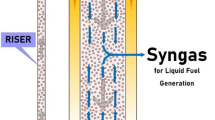Abstract
The heat transfer effect of an inert gas on a multi-tubular reactor for a partial oxidation reaction has been determined. The model reaction system in the study was partial oxidation of propylene to acrolein. Both theoretical modeling and experimental studies have been performed to determine the heat transfer effect of inert gas on the system. Among many inert gases, CO2 was selected and tested as a diluent gas for the partial oxidation of propylene to acrolein system instead of conventionally used N2. The productivity increase through changing the inert gas from N2 to CO2 was possible due to the heat transfer capability of CO2. In this study, by replacing the inert gas from N2 to CO2, productivity increased up to 14%.
Similar content being viewed by others
References
Byun, Y. C. and Lee, W. H.,“Process for Manufacturing Catalysts for the Acrolein and Methacrolein Production” KR Patent, 99-21570 (1999).
Calderbank, J. J. and Pogorski, L. A.,“Heat Transfer in Packed Beds,”Tras. Int. Chem. Eng. (London),35, 195 (1957).
Carberry, J. J.,“Chemical and Catalytic Reaction Engineering,” McGraw-Hill, New York (1976).
Choi, J. and Eigenberger, G.,“Dampfeinsparung Durch Peiodische Katalysator-Reaktrivierung Bei Der Styrol-Synthese,”Chem-Ing.-Tech.,61(8), 641 (1989).
Doraiswamy, L. K. and Sharma, M. M.,“Heterogeneous Reactions: Analysis, Examples, and Reactor Design,” Wiley, New York (1984).
Franzen, E. P., Maycock, R. L., Nelson, L. E. and Smith, W. C.,“Tubular Catalytic Reactor with Cooler” US Patent 3147084 (1964).
Froment, G F. and Bischoff, K. B.,“Chemical Reactor Analysis and Design” Wiley, New York (1979).
Jung, K. Y., So, J. H., Park, S. B. and Yang, S. M.,“Hydrogen Separation from the H2/N2 Mixture by Using a Single and Multi-Stage Inorganic Membrane”Korean J. Chem. Eng.,16,193 (1999).
Ko, D., Lee, W. H. and Paek, K. H.,“The Preparation Method for Partial Oxidation Catalyst” KR Patent, 177326 (1998).
Petrovic, L. J. and Thodos, G.,“Mass Transfer in the Flow of Gases Through Packed Beds”Ind. Eng. Chem., Fundamentals,7, 274 (1968).
Roach, P. J.,“Computational Fluid Dynamics” Hermosa, Albuquerque, N. M. (1972).
Rowe, P. N., Claxton, K. T. and Lewis, J. B.,“Heat and Mass Transfer from a Single Sphere in an Extensive Flowing Fluid”Trans. Inst. Chem. Eng.,43, T14 (1965).
Satterfield, C. N.,“Mass Transfer in Heterogeneous Catalysis”The Massachusetts Institute of Technology,78 (1970).
Song, K. H. and Park, K. H.,“Process Development of Acrylates” LG Chem research report (1998).
Szekely, J., Evans, J. W. and Sohn, H. Y.,“Gas-Solid Reactions” Academic Press, New York (1976).
Tan, H. S., Downie, J. and Bacon, D. W.,“The Reaction Network for the Oxidation of Propylene over a Bismuth Molybdate Catalyst”Can. J. Chem. Eng.,67, 412 (1989).
Author information
Authors and Affiliations
Corresponding author
Rights and permissions
About this article
Cite this article
Song, K.H., Han, S.E. & Park, KH. Heat transfer effect of inert gas on multi-tubular reactor for partial oxidation reaction. Korean J. Chem. Eng. 18, 184–189 (2001). https://doi.org/10.1007/BF02698457
Received:
Accepted:
Issue Date:
DOI: https://doi.org/10.1007/BF02698457



